Ultimate Guide to Keeping Frogs in a Koi Pond
As we dreamed of building a larger pond for the koi that rapidly outgrew their little stock tank pond, we wanted it to support the larger community of insects and animals native to our area. Specifically, I really wanted frogs. When we installed our first pond, the stock tank pond, we also added a few bullfrog tadpoles and tree frog tadpoles, which grew into adults. We heard the tree frogs chirping after a couple summer showers, but they eventually hopped off to the woods. The bullfrogs stayed around for a few years. We’d tiptoe outside to the pond at night wearing head lamps and spot the bullfrogs hunting for insects in the garden. Eventually their numbers dwindled down to just one bullfrog named Biggie, whom we would feed earthworms by hand, until he bit my finger and drew blood. After one final winter, Biggie was gone. That first wave of frogs never reproduced in the stock tank pond.
In the late Spring of 2023, we completed the koi pond. Again, we introduced tadpoles and a young female adult bullfrog, whom we named Olan. By the end of the summer, we had several adult frogs. We observed that the frogs would occasionally switch ponds and move from the garden stock tank pond to the koi pond and back overnight. In March of 2024, our friend dropped off a male bullfrog for us that they had found in their backyard. Once the weather warmed, we began hearing bullfrog calls at night. One morning I found that Olan, who normally stayed in the stock tank pond, had moved over to the koi pond. A few days later, I was looking down into the bog area of the koi pond and noticed a sac of frog eggs. We brought a couple scoops into an aquarium so we could observe the changes and make sure the koi didn’t eat all the eggs. I also added another layer to the rock wall separating the bog filter from the main pond to keep the fish out of the shallow water. Eventually we released the indoor tadpoles back into the pond as we saw the ones outside were growing much more quickly. A month later I discovered another batch of eggs in a water lily. Before long, polliwogs were hanging off lily pads with their funny rounded faces and stubs for tails.
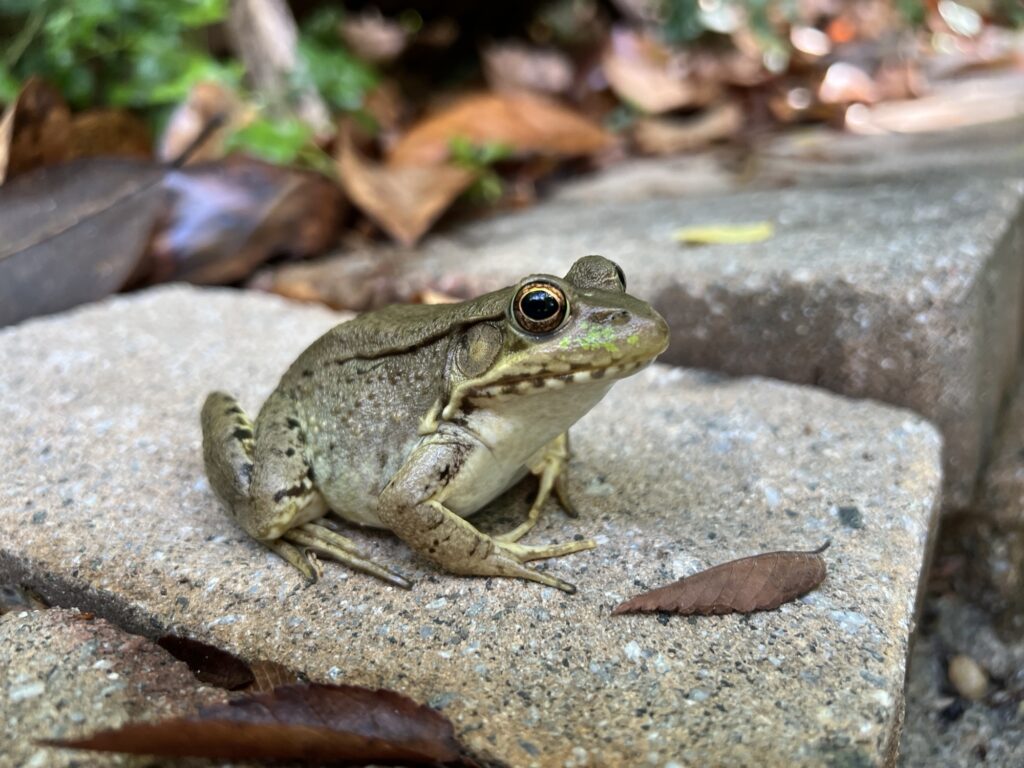
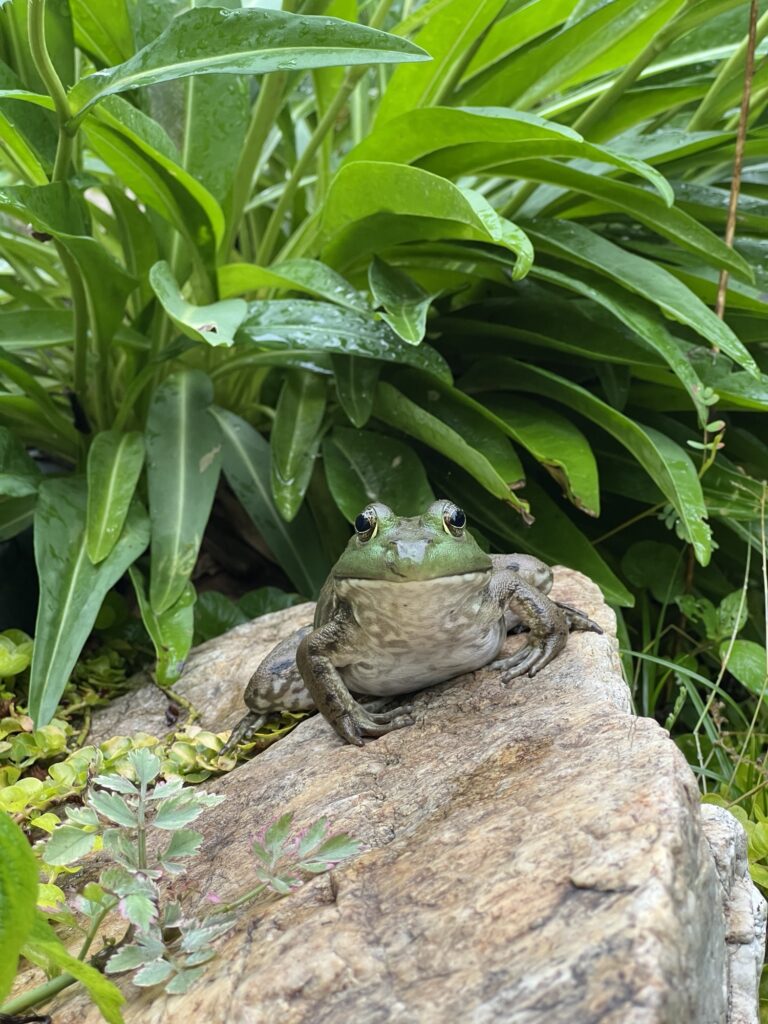

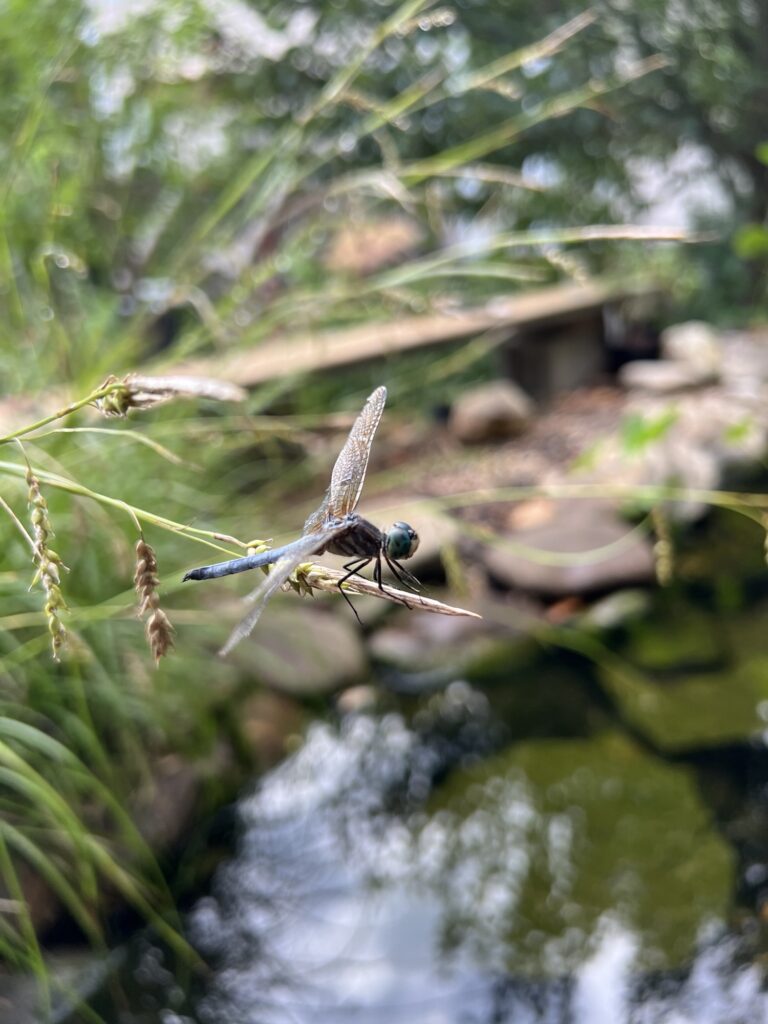
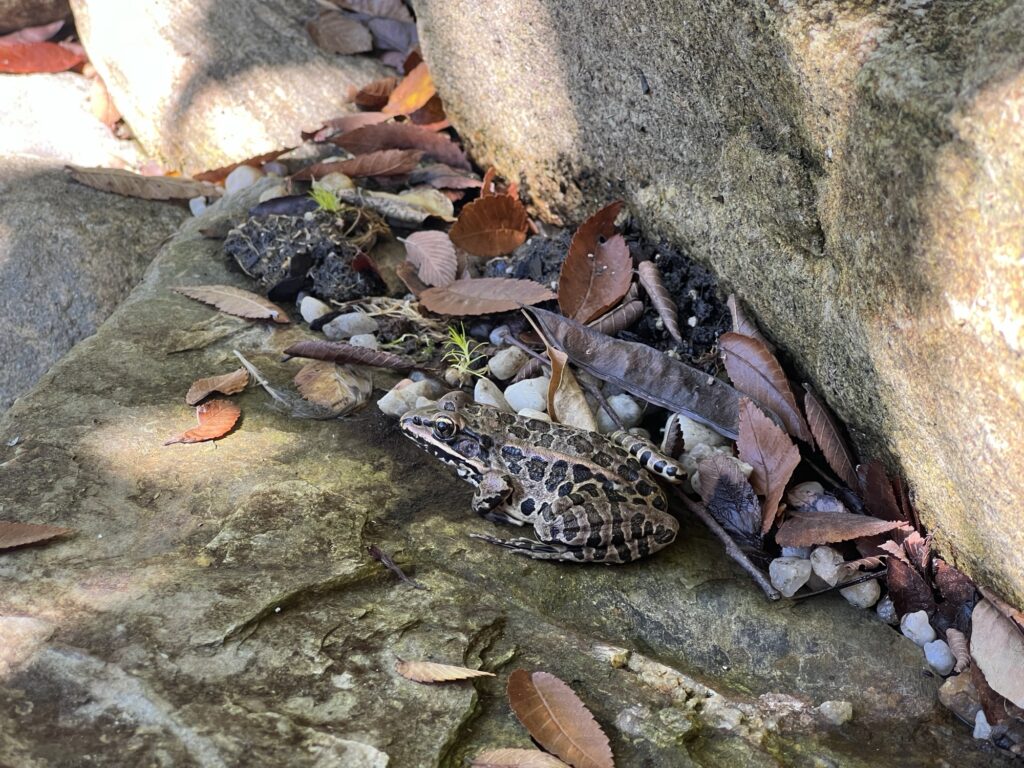
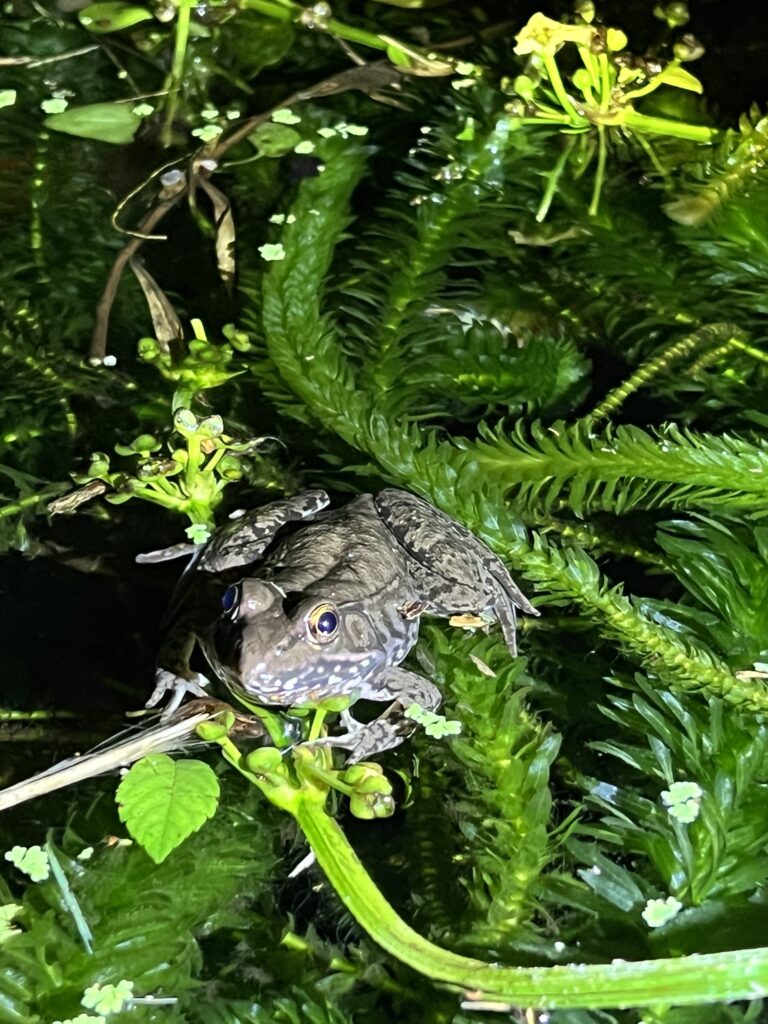

Fast forward to Fall and we’ve now seen Bullfrogs, Green Frogs and a Pickerel Frog. We don’t know if these frogs found our pond or if the batch of tadpoles we introduced in the spring was a mix of species. Either way, the frog eggs in the bog filter proved that our habitat was hospitable to a growing frog community. Today our backyard koi pond is much more than a menagerie of colorful fish; it’s a thriving ecosystem teeming with life. While any puddle of water has the potential to attract frogs looking to drop off some eggs, there are ways to design a pond that will support wildlife and hopefully keep it around.
Elements of Good Pond Habitat
Varied Water Depths
Fish and amphibians use the shallow zones to spawn. The tadpoles feed on plants and algae in the shallow and medium depths and dive down deep for protection. Both the fish and the frogs my eat the tadpoles and fish spawn, so it’s important to have shallow areas inaccessible to the fish and to make sure you are providing other food sources. You cannot really control where the frogs go, but if there are plenty insects, the offspring will have a better chance. The deeper areas, 3 – 4ft depth, provide cooler temperature and protection from overhead attacks from predators such a raptors. Different aquatic and pond plant species prefer different planting depths.
Diverse native vegetation
Vegetation offers so many benefits – filtration, shade, protection, food sources, and landing zones for insects. The pond vegetation is much more than what goes in the water like water lilies, American lotus, lizard tail, and pickerel weed, which the insects all love. Sedges on the banks provide shelter for the frogs as they wait to insects to land and keep them hidden from predators. Ferns overhang the waterfall and provide hiding spots for the frogs. The overhanging vegetation and tree branches of the redbud, fruit trees, pawpaw, elderberry, elm and magnolias also shade the shallow water at the edges which helps control algal growth. These trees all produce seeds, berries and fruit which feed the birds and other wildlife. Around the banks of the pond are native blooming perennials that attract pollinators. I have a pond plant catalog if you are looking for ideas of what to plant.
Underwater Shelter
The mix of large and small stones created gaps for minnows and tadpoles to hide. Stacked rocks topped with flagstones function as underwater caves for the koi to shelter under in the winter when they are inactive or in the heat of the summer to stay cool. They also keep them hidden from flying predators. Old broken planters can also be useful habitat features. I also have an overturned broken terracotta pot in the bog filter that is half submerged. The frogs use this as a hiding spot. I found a really cool pot with multiple openings that I also submerged on an underwater shelf to plant a water lily. I’ve seen tadpoles and fish dart in and out of the holes.
Moving Water Feature
Our waterfall oxygenates the pond, creates a current to move fallen leaves to the filter box, and filters the water up at the waterfall basin at the top. The large bullfrog has made that small basin his personal abode. The sound of the running water also attracts birds. Nearly every day I see mourning doves land on the waterfall and take a drink. Last winter, the waterfall attracted a flock of cedar waxwings for several days.
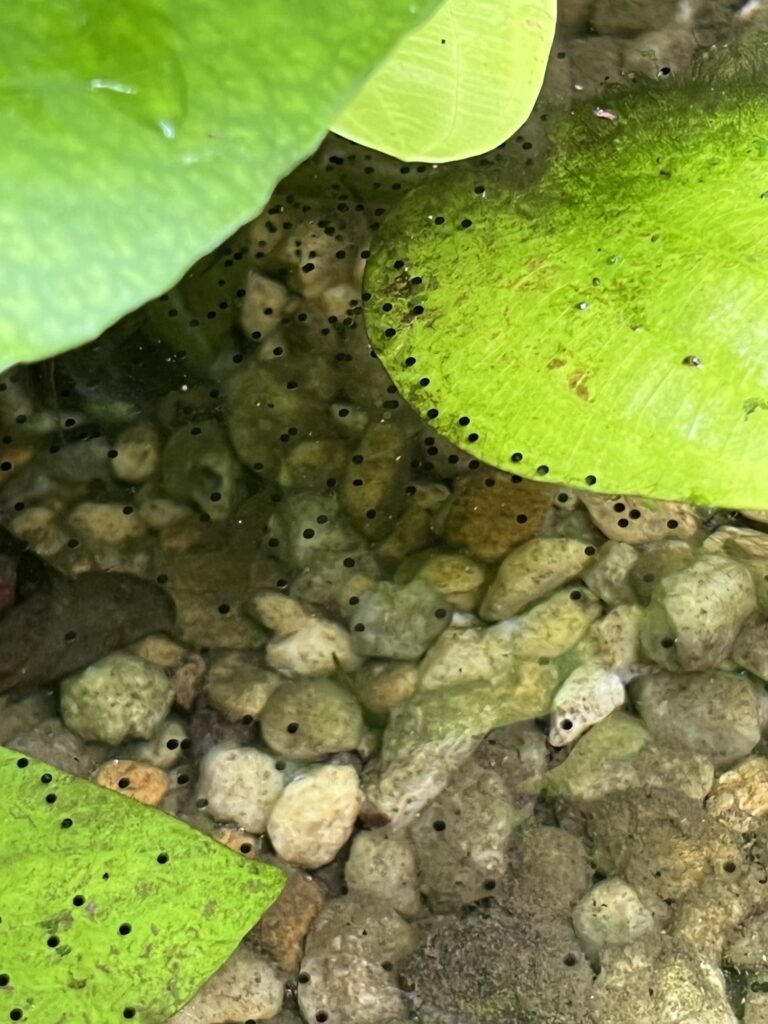
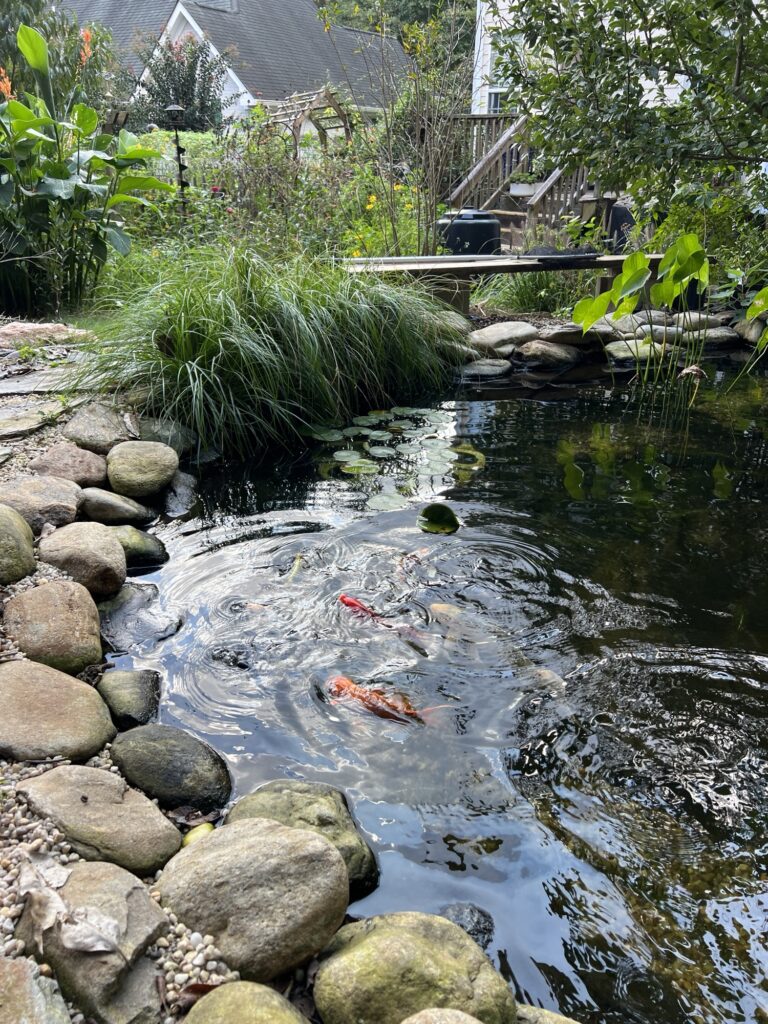
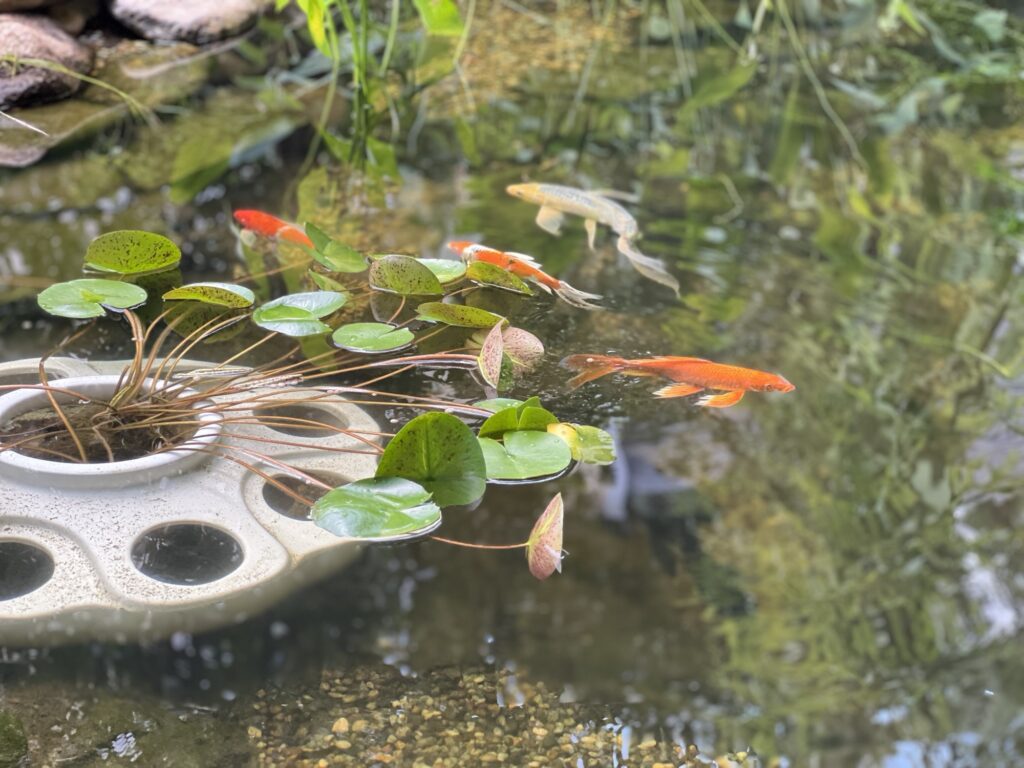
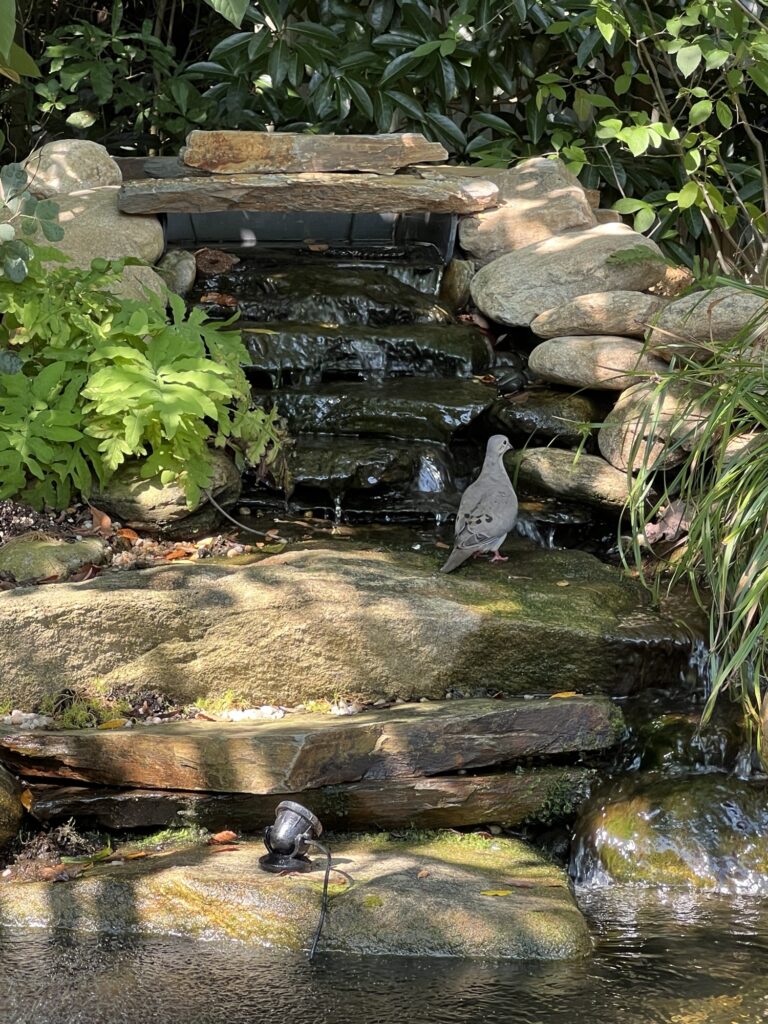
What do tadpoles eat? Do I need to feed them?
Tadpoles will eat algae, aquatic plants, decaying plant material, and insects. In the summer, the tadpoles do a great job of keeping the algae at bay!
Frog diet of common pond species in the North Carolina Piedmont*
*These are the Lithobates or American water frogs. The table does not include toads or tree frogs and relatives.
| Species (links go to https://herpsofnc.org) | Diet |
| American Bullfrog | aquatic eggs and any moving prey: insects, frogs, fish, reptiles, birds and mammals |
| Green Frog | insects, worms, spiders, snails, small fish, crayfish, shrimp, other frogs, tadpoles, and small snakes |
| River Frog | Beetles, crayfish, leeches, and other small invertebrates; also fishes, frogs, small snakes |
| Pickerel Frog | ants, spiders, various bugs, beetles, sawfly larvae, and other invertebrates |
| Southern Leopard Frog | Insects, Earthworms, Spiders, Centipedes, Snails, Beetles, and Smaller frogs |
Is collecting tadpoles from the wild in North Carolina allowed?
When I started by first pond, I sourced some plants, tadpoles, and bucket of pond water from another homeowner with a pond. A local plant nursery allowed me to take tree frog tadpoles from their water lily tanks. I then wondered about collecting tadpoles from the wild and looked up the North Carolina rules. Whether or not you may collect amphibians (tadpoles were not directly mentioned) from the wild depends on the species and how many you are collecting. In North Carolina, the Bullfrog, Green Frog, Pickerel Frog, Southern Leopard Frog are all classified as nongame species with no open season; therefore, limited collection without a license is allowed.
Individuals collecting and holding reptiles or amphibians for personal use shall not be required to obtain a Wildlife Collection License so long as the following conditions are met:
(1) no more than 4 individuals of native reptile species or 24 individuals of any combination of
amphibian species per person;
(2) collected reptiles and amphibians shall not be bought or sold; and
(3) no endangered, threatened, or special concern species shall be collected and retained
(Scientific Wildlife Collection Rules from the North Carolina Office of Administrative Hearings)
There are three species of endangered frogs in North Carolina: Gopher frog (Rana capito)
Ornate chorus frog (Pseudacris ornata), and River frog (Rana heckscheri). There is one protected species: Pine Barrens treefrog (Hyla andersonii). North Carolina species of concern are: Northern gray treefrog (Hyla versicolor), Mountain chorus frog (Pseudacris brachyphona), and Southern chorus frog (Pseudacris nigrita). See the handout: https://www.ncwildlife.org/protected-wildlife-species-ncpdf/download?attachment.
How do I identify which tadpole species I have?
Here are guide: to help:
https://ashtonbiodiversity.com/home/education/visual-guide-to-tadpoles/
Visual Guide to Tadpoles and Morphs of the Eastern U.S.
http://fwf.ag.utk.edu/mgray/wfs493/HovermanLarvaeID.pdf
Will the frogs stay at my pond?
They may or they may not. Some species stay around the pond (Bullfrog), and some wander off to find a new body of water (Green Frog).
Where do they go in the winter?
Aquatic frogs hibernate underwater at the bottom of the pond in the mud and leaf litter. It’s a good reason NOT to keep your pond too clean.
Be Prepared for Predation
A quick word about the American Bullfrog – these frogs have voracious appetites. Bullfrogs may out-compete all the other frog species in your pond. They have been observed to eat other frogs, fish and even small birds. If you are attempting to breed your fish, make sure there are plenty aquatic plants and hiding spots for them. Will bullfrogs eat older koi? Basically, if the fish can fit in the frog’s mouth, there is a chance the frog will eat the fish. We started out with small 3-5″ butterfly koi from the pet store and have not lost any to frogs that we know of. Larger koi can be very expensive, but pet store koi cost me between $12-$17 each at the time I purchased them. The saddest loss we experienced in regards to the koi was when a barred owl took our largest butterfly koi from the stock tank pond before we had built the koi pond. Many pond owners deal with owls, herons, and other birds taking fish and will cover their ponds with nets to protect their fish from overhead attacks. If you are wanting to keep frogs in the pond, keep in mind that a net could injure frogs. Personally, I stick to providing fish caves and hoping for the best.
Plan on Nightly Noise
Frogs are quite the crooners during breeding season. Our male was giving it his best all summer, especially at 4 am. I grew up next to a large pond and love the sound of bullfrogs in the summer, but I also sleep with earplugs. The USGS has samples of frog calls if you want to compare what you hear outside to help you identify frogs.
Learn more about frogs:
This post contains affiliate links. If you use these links to buy something we may earn a commission.


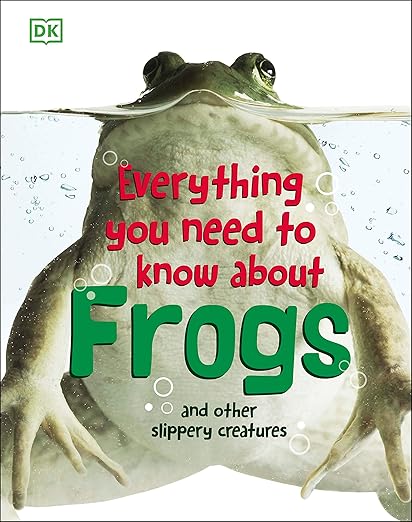
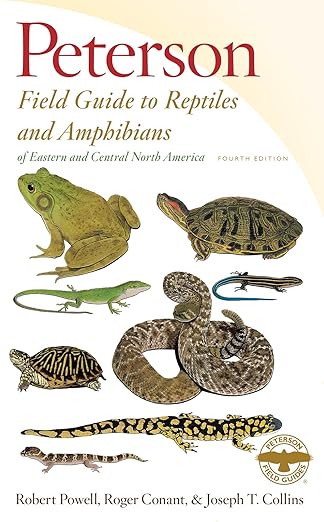
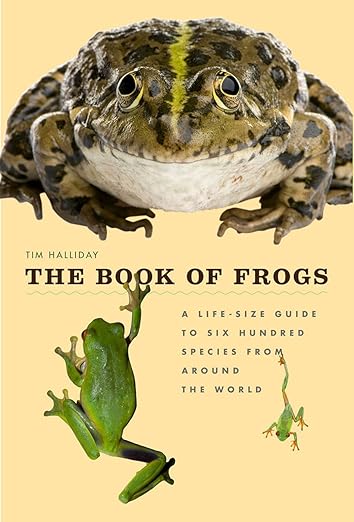
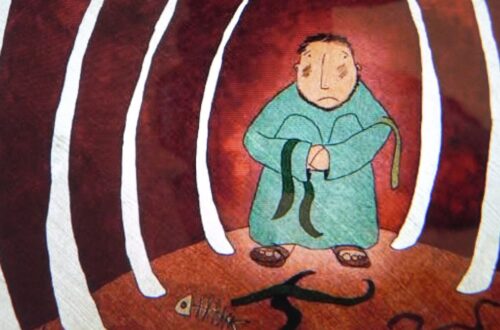
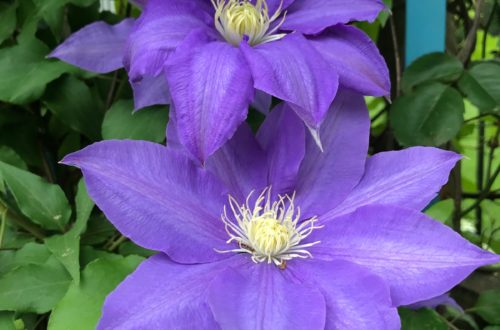
2 Comments
Mike
Saw a submerged pot for Lillie in your photos. Where can this be attained?
Portland, Oregon
Paige Puckett
I found that in a Home Goods! When you see something amazing at Home Goods, you don’t pass it up.